Carbonates: Malachite
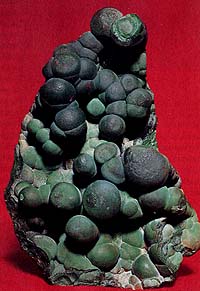 Diagnostic card.
Diagnostic card.
On the picture. Concretive malachite of the kidney-like structure from Shaba (Zaire).
Cu 2 CO 3 (OH) 2
Singonia monoclinic
Hardness 4
Specific weight 4
Cleavage is easily manifested
Cracked shell
Color emerald green
Color in powder green
Gloss from wax-glass to silky
The name is given, probably for a green color, reminiscent of the color of the leaves of the mallow (Greek malache - mallow), or for the low hardness of the mineral (Greek malakos - soft). On the ground surface of malachite, a pattern is opened from alternating light and dark concentric rings, straight strips or a pattern of a more complex configuration due to the concentric structure of the aggregates. More or less monochromatic pieces are rare.
In isolated, very rare cases, malachite occurs in the form of individual small crystals collected in bundles. Usually it forms microcrystalline aggregates of a concretional, sometimes stalagmite form. Usually in malachite bodies the size, for the most part, from a few millimeters to several decimeters, - the structure is zonal: alternating strips of fibrous-radiant structure, concentric or banded.
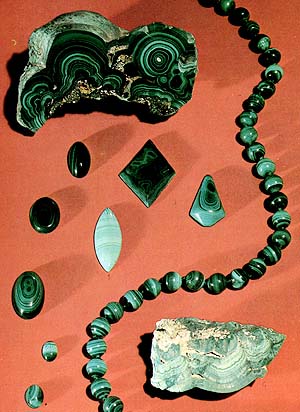 The color of the bands is intense green or yellowish green, sometimes they alternate with the blue ones, associated with the presence of azurite. Glitter aggregates can vary from waxy-glass to silky in fibrous aggregates. Individual fibers are sometimes discernible to the naked eye.
The color of the bands is intense green or yellowish green, sometimes they alternate with the blue ones, associated with the presence of azurite. Glitter aggregates can vary from waxy-glass to silky in fibrous aggregates. Individual fibers are sometimes discernible to the naked eye.
Chemical composition - content (in%): CuO - 71.9; CO2-19.9; H2O-8.2. Prismatic view of symmetry. Cleavage is absent. Crystals are rarely seen, usually prismatic with facets (100), (110), (010), (201). Twins are developed in accordance with (100). Most often observed in the form of crusts, spherocrystals, infiltrating kidney-shaped aggregates radial-radiant, parallel-columnar and zone-concentric structure
Diagnostic signs.
Malachite is not too hard, brittle, it breaks into pieces when it strikes; Reacts to hydrochloric acid with rapid effervescence. Copper (the content of which in the mineral is more than 70%) causes a green color, and when the powder of the mineral contacts the flame, it turns green. Melts pretty easily. Ural malachite has such a characteristic appearance that it is impossible to confuse it with malachite, imported from other countries. Sometimes malachite forms close intergrowths with azurite - azur-malachite, more rarely - with turquoise and chrysocolla.
Origin.
Malachite is a secondary mineral formed in the zone of near-surface oxidation of copper deposits.
Deposits and applications.
In the past, malachite was mined in the Urals (there were blocks weighing up to fifty tons) and in the mines of Ancient Egypt. Now it is mined in Australia, Zaire, Zimbabwe, Arizona (USA), Chile, France and Germany. In Italy, malachite is found in Sardinia (Campo Pesaro, Cagliari region), Libiol (Liguria region), Carnia and Elba (Capo Kalamita). Malachite from ancient times, because of its intensely green color and concentric zonation, found wide application. Now it is used in jewelry business and as a very expensive ornamental stone.
Now the main supplier of malachite to the world market is Zaire (Kolvezi). Malachite is partially processed directly on the spot, and partly comes to the market in raw form. In addition, malachite deposits are available in Australia, Chile, Zimbabwe, Namibia, the USA (Arizona) and the CIS (Ural, Kazakhstan).
Application in jewelry.
In the jewelry business, malachite is used for processing in the form of a tondo or oval and cut into a cabochon. Malachite also goes to expensive art crafts - caskets, balls, knife handles, candelabra, etc.

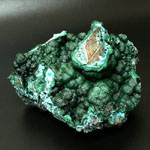
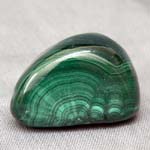
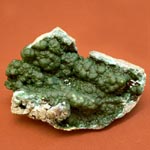


Malachite. Lower. Tagil, Wed. Ural, Russia, the CIS. More than 15 cm. Photo: © А.А. Evseev.
Aggregates of malachite consist of the smallest crystals. Large crystals are very rare and very much appreciated by collectors. Untreated malachite is characterized by a weak glass shine, but on fresh fracture and polishing, its shine is often silky. Malachite is sensitive to heating and is unstable with respect to acids, ammonia, it also breaks down in hot water. The mineral is usually represented by kidneys, bunchy, pineal, stalactite-like secretions, less often flat crusts. Occurs when copper solutions are exposed to carbonate rocks in the immediate vicinity of copper deposits and in their oxidation zone. The most famous malachite deposits were located in the Urals. It was here that malachite was mined for facing fireplaces, countertops, pilasters and vases of the Malachite Hall of the Winter Palace, as well as columns of St. Isaac's Cathedral in St. Petersburg.
Despite the low hardness and instability, malachite today is one of the most popular jewelry and decorative stones. It is polished with cabochon or slightly convex tablets, beads made of it, as well as small cabinet decorations - boxes or stands for candlesticks, watches, ashtrays and small figures. When processing malachite try to maximize the decorativeness of the stone. Especially appreciated is the "eyeball" malachite with thin concentric rings - "peacock eye". In large pieces of malachite can not be confused with anything, in small products, where banding is not visible, it looks like many opaque green stones.
At present (including in the CIS) the problem of obtaining artificial malachite, suitable for jewelry, has been solved; Elegant inexpensive beads from such malachite already actively go on sale.
- Ghetchellit - "New Almaden blend" - arsenide and antimony sulfide (modern sulfosol)
- Antimony is a toxic metal (semimetal) , widely used in metallurgy, medicine and engineering
- Zirconium - a rare and undiscovered metal and the most dangerous precious stone in oxide and salt
- Gold - yellow dangerous and poisonous metal of modern accurate digital and cable technologies
- Sulfur is a golden-yellow toxic substance and a sign of active volcanic activity
- Cadmium is an undisputed toxic silvery metal unknown to a wide range of people
- Lead - a toxic gray imitator of metallic silver and toxic metal blende
- Arsenic is a classic poison of medieval and modern poisoners and medicine in medicine
Poisonous and radioactive dangerous stones and minerals
** - poisonous stones and minerals (mandatory check in the chemical laboratory + explicit indication of toxicity)
** - radioactive stones and minerals (mandatory check on the standard dosimeter + ban on open sales in case of radioactivity exceeding 24 milli / g / h + additional measures of population protection)
Catalog of minerals and semi-precious stones of the world by groups
** - poisonous stones and minerals
** - radioactive stones and minerals


Comments
When commenting on, remember that the content and tone of your message can hurt the feelings of real people, show respect and tolerance to your interlocutors even if you do not share their opinion, your behavior in the conditions of freedom of expression and anonymity provided by the Internet, changes Not only virtual, but also the real world. All comments are hidden from the index, spam is controlled.